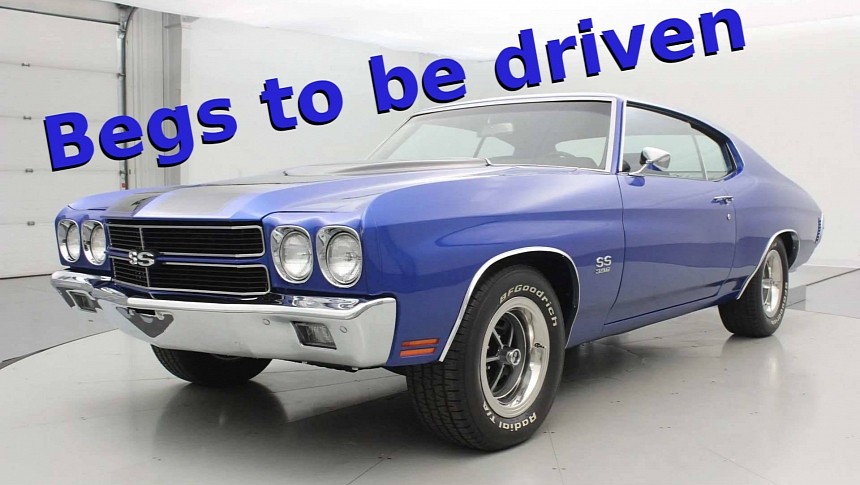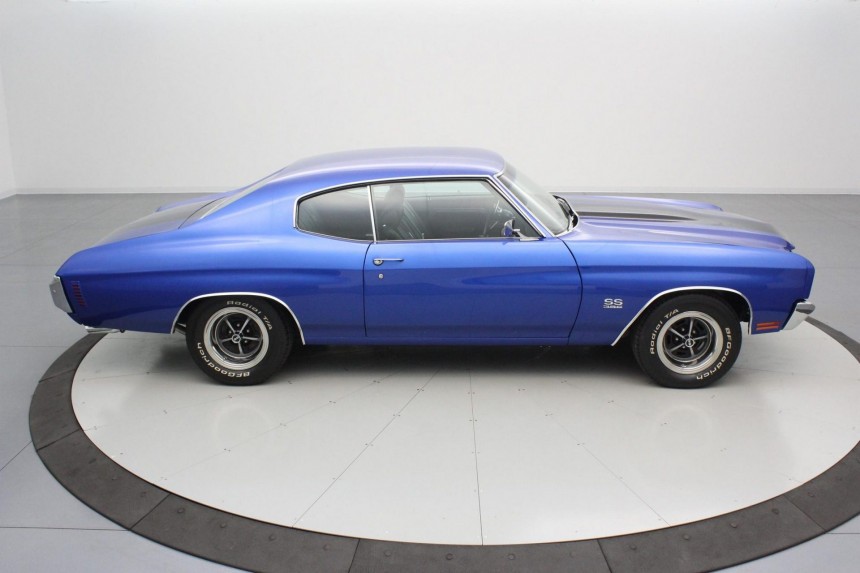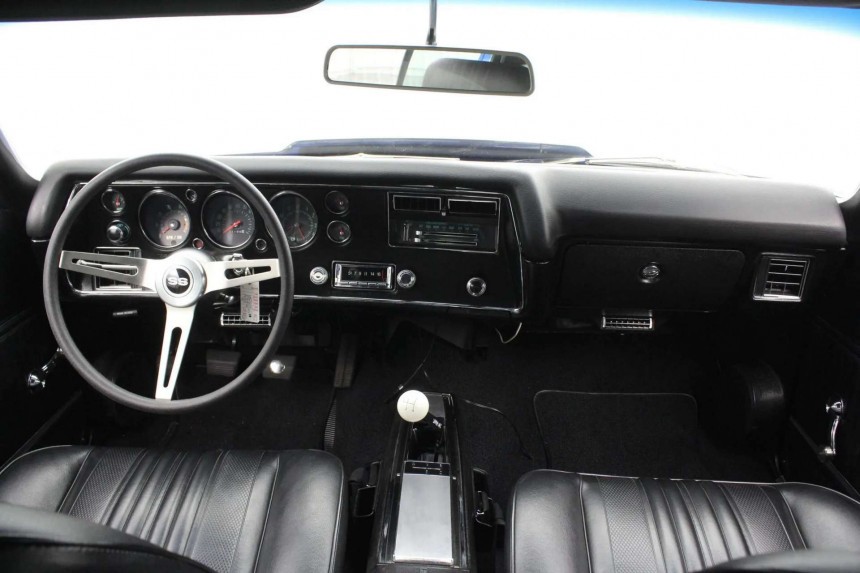With its sleek design, the Chevelle was arguably one of the most beautiful muscle cars, and, just before the beginning of the malaise era, it became a fearsome car to meet on a drag strip or see in the rearview mirror, especially if it was fitted with the 454 engine. Even the less-powered version, the SS396, was no slouch. It is also the case for the car that you see here, which also hides a little secret.
When Chevrolet introduced the second generation of the Chevelle in 1968, it made it to race against other muscle cars that were offered by Chrysler, especially those fitted with the mighty Hemi engines. But it didn't exactly match the carmaker's expectations since it didn't have engines that were big enough. So, in 1970, the bow-tie brand decided to lift the ban on displacement. Thus, the mighty 454 version has seen the broad light.
Besides the big V8 under the hood, the SS versions were restyled with new front fenders, a doomed hood, and a new grille that sported the double-S badge. Another significant update was for the rear end, where the taillights got integrated into the bumper along with the reversing lights. Moreover, the interior was also restyled and featured a new instrument cluster. There's no wonder that the Chevelle became one of the most appreciated muscle cars ever produced.
In 1970, Chevrolet produced around 53,000 units of the Chevelle SS396 and less than 10,000 from the mighty SS454. That was due to the significant price difference between these versions. It was also a huge gap between them in terms of power. While the former was available with either 350 hp (L34) or 375 hp (L78), the latter was provided with up to 450 hp for the LS6 variant. Nevertheless, all of them had enough muscle to spin the tires and cover the quarter-mile run in less than 15 seconds, with the LS6 version credited with achieving that in the low 13s.
But then, the emission controls and the insurance prices hit the muscle cars market. Then, the last nail to the coffin was the first oil crisis that started in 1973, bringing the whole muscle car era to a halt. Soon, many former glories from the race tracks were parked and forgotten in barns and garages, waiting for better days to come. And these days are here.
We don't know how many years it had to wait since the EV revolution began, and it spread like wildfire. Nowadays, there are electric SUVs that can cover the quarter-mile run faster than a Plymouth Road Runner 440-6. But as we all know, muscle cars are not providing just fun on the track; they are offering a true sound that no battery-powered vehicle can deliver. It's the whole experience that matters most, even when you're driving it at 15-25 mph (25-40 kph) in school zones.
But since there were so few Chevelles produced with the 454, prices for these versions are going through the roof. In addition, not everybody is ready to spend a six-figure price for a vehicle to drive on a daily or even just during weekends. So, the next best thing is the SS396, such as the one that you see here.
Originally, this car was painted in Misty Turquoise, but now it's blue. It also sports two black lines over the hood and trunk. In addition, the wheel arches are adorned with chromed trims. We know it is not an all-original vehicle, but it is one that you can drive more often than one that costs more than your home. For keeping the car planted to the road, the previous owner installed a set of 225/60 BFGoodrich Radial T/A white-letter tires wrapped around 15” Rally-style wheels that sport the SS center caps.
Inside, there is a completely restored cabin with black vinyl upholstery and a similar-looking headliner and door cards. In addition, the dashboard was refreshed, and a vintage-looking push-button stereo was installed. You can also drive this car during the hot summer since it has an AC unit. To obey the law, there are four lap belts for the front bucket seats and the rear bench seat.
This car's secret can be found under the hood. According to the seller, powering this blue beauty is a replacement 396 engine bored to 402 cu-in (6.6-liter) engine that sends all its oomph to the rear wheels via a Muncie four-speed manual. We don't know which one it is since there were three versions (M20, M21, and M22). There is also no mention of the type of rear axle, so you might want to ask the seller for that.
According to the pictures, the car shows no rust signs whatsoever, so it might be ready for its next owner. To confidently stop this approximately 3,700 lbs (1.7-ton) vehicle, Chevrolet installed power-assisted brakes, with discs up front and drums in the rear. The car also features power steering, so you won't feel like working too much to drive this vehicle on the street.
But if you want to learn more about this 1970 Chevelle Malibu Sport Coupe, you can book a trip to Salina, Kansas, where the car is located. But do that by April 23, 2023, when the auction will end.
Besides the big V8 under the hood, the SS versions were restyled with new front fenders, a doomed hood, and a new grille that sported the double-S badge. Another significant update was for the rear end, where the taillights got integrated into the bumper along with the reversing lights. Moreover, the interior was also restyled and featured a new instrument cluster. There's no wonder that the Chevelle became one of the most appreciated muscle cars ever produced.
In 1970, Chevrolet produced around 53,000 units of the Chevelle SS396 and less than 10,000 from the mighty SS454. That was due to the significant price difference between these versions. It was also a huge gap between them in terms of power. While the former was available with either 350 hp (L34) or 375 hp (L78), the latter was provided with up to 450 hp for the LS6 variant. Nevertheless, all of them had enough muscle to spin the tires and cover the quarter-mile run in less than 15 seconds, with the LS6 version credited with achieving that in the low 13s.
But then, the emission controls and the insurance prices hit the muscle cars market. Then, the last nail to the coffin was the first oil crisis that started in 1973, bringing the whole muscle car era to a halt. Soon, many former glories from the race tracks were parked and forgotten in barns and garages, waiting for better days to come. And these days are here.
But since there were so few Chevelles produced with the 454, prices for these versions are going through the roof. In addition, not everybody is ready to spend a six-figure price for a vehicle to drive on a daily or even just during weekends. So, the next best thing is the SS396, such as the one that you see here.
Originally, this car was painted in Misty Turquoise, but now it's blue. It also sports two black lines over the hood and trunk. In addition, the wheel arches are adorned with chromed trims. We know it is not an all-original vehicle, but it is one that you can drive more often than one that costs more than your home. For keeping the car planted to the road, the previous owner installed a set of 225/60 BFGoodrich Radial T/A white-letter tires wrapped around 15” Rally-style wheels that sport the SS center caps.
Inside, there is a completely restored cabin with black vinyl upholstery and a similar-looking headliner and door cards. In addition, the dashboard was refreshed, and a vintage-looking push-button stereo was installed. You can also drive this car during the hot summer since it has an AC unit. To obey the law, there are four lap belts for the front bucket seats and the rear bench seat.
According to the pictures, the car shows no rust signs whatsoever, so it might be ready for its next owner. To confidently stop this approximately 3,700 lbs (1.7-ton) vehicle, Chevrolet installed power-assisted brakes, with discs up front and drums in the rear. The car also features power steering, so you won't feel like working too much to drive this vehicle on the street.
But if you want to learn more about this 1970 Chevelle Malibu Sport Coupe, you can book a trip to Salina, Kansas, where the car is located. But do that by April 23, 2023, when the auction will end.















